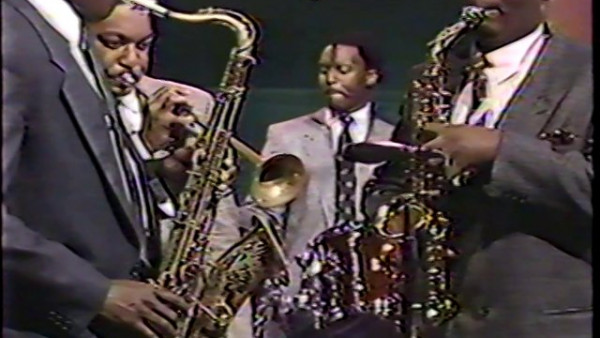Signs of Intelligent Life in Music Television
One evening this month as I was riffling through television by remote control, I happened to spot the stern, cherubic face of Wynton Marsalis. The young jazz trumpeter was the guest on a program called ‘‘New Visions,’‘ a weekly two-hour series that airs on Sundays at 10 P.M. on the 24-hour cable music channel, VH-1. The program is one of many welcome signs that music-oriented television, which arrived with a splash in 1981 with MTV, has discovered that there is life beyond the flashy video clip.
In addition to performing live with his sextet, Mr. Marsalis was interviewed at length by Ben Sidran, the jazz pianist, songwriter and music historian who has been the program’s host since early July. An eloquent, outspoken educator as well as a superb musician, Mr. Marsalis spent most of the interview lambasting the music industry with the sort of pained, personal observations rarely expressed by musicians anywhere, least of all on television.
Nudged along by Mr. Sidran, the trumpeter bitterly lamented the weakening position in American music of the blues-based jazz tradition that extends from Louis Armstrong through Charlie Parker. The blues, he maintained, embodied the spiritual essence of America – an essence that was eroding through neglect.
He placed much of the blame on contemporary music merchants, whom he accused of cynically creating and promoting a market for the artistic and spiritual equivalent of candy. In the same way that candy rots teeth, he said, the promotion of music without spiritual value was contributing to the country’s cultural rot. And he denounced the racist stereotype of the black jazz musician as noble savage for falsely discrediting a rigorous and scholarly musical tradition.
Whether one agrees with Mr. Marsalis’s dour assessments is beside the point. Simply to hear such big ideas expressed in larger than bite-sized phrases on a channel that three years ago was offering fluff in the name of sophisticated entertainment struck me as very encouraging. The following Sunday’s ‘‘New Visions’‘ included an interview with Brian Eno, the English pioneer of ambient music, interspersed with music-video clips of work he created with Roxy Music and Talking Heads. Last Sunday, Mr. Sidran’s guest was the tenor saxophonist Illinois Jaquette. This evening the program will feature the pop-jazz flugelhornist Chuck Mangione and the singer and composer Jon Hendricks.
‘‘New Visions’‘ is only one way in which VH-1 has begun to outshine its once-hipper cousin, MTV. When VH-1 was launched in January 1985, it tottered onto the air like a curmudgeonly older relative of the ground-breaking music-video channel. Then, as now, VH-1 was designed to appeal to an older age group – those between 25 and 49 – than MTV, whose ideal viewing audience ranges from 12 to 34.
During its first year, the channel was a poorly programmed dumping ground for video clips that were considered too unhip for MTV audiences. Most adult rock artists were excluded from the channel, which concentrated on easy-listening fare by Julio Iglesias, Diana Ross, Alabama, Barry Manilow, Neil Diamond and Willie Nelson. The clips were strung together in a careless mishmash of styles. The prototypical VH-1 song in the early days was Bertie Higgins’s innocuous 1981 pop hit ‘‘Key Largo,’‘ which seemed to come on regularly every hour.
Then, two years ago, the channel changed direction and began cultivating a baby-boomer audience. Instead of Julio Iglesias and Alabama, it offered Paul Simon, Bruce Springsteen, Steve Winwood, Carly Simon, Anita Baker, James Taylor, Sade and Phil Collins. Months before Tracy Chapman’s music video ‘‘Fast Car’‘ was seen on MTV, it was programmed on VH-1.
The channel also recruited a young, peppy breed to introduce the music. And it has begun devoting whole weekends to spotlighting individual artists, augmenting video clips with rare concert footage and interview material to offer rich overviews of individual careers. During the first week of October, the channel devoted an entire week to John Lennon to celebrate the release of the film ‘‘Imagine.’‘
VH-1 also hired Bobby Rivers, a bespectacled, black 34-year-old interviewer, humorist and writer from Los Angeles who became so popular as a video jockey that he was given his own weekly half-hour interview show (at 10:30 P.M. on Tuesdays), ‘‘Watch Bobby Rivers.’‘ Mr. Rivers is a disarmingly sweet, quirky personality who exudes a benign sense of mischief as he joshes with stars ranging from the Nashville rocker John Hiatt to Sigourney Weaver. A nerdy, post-collegiate Eddie Murphy with no axes to grind, he is a master interviewer with a gift for light, impromptu banter, and he is equally comfortable interviewing movie stars, authors and musicians.
Of course, there is still plenty of room for improvement on VH-1. Its video jockeys go to hyperactive lengths to avoid appearing bland. And much of the channel’s gossipy ‘‘Entertainment Watch’‘ segments are as coldly canned as ‘‘Entertainment Tonight.’‘ Its regular music-video programming, though greatly improved, could still use some toughening up.
Since it would absurd to expect a commercial music channel like VH-1 to devote the bulk of its programming to music outside the commercial mainstream, one must be grateful for the risks it does take – like allowing Mr. Marsalis to sound off at length against the pop establishment to which the channel belongs.
by Stephen Holden
Source: The New York Times

